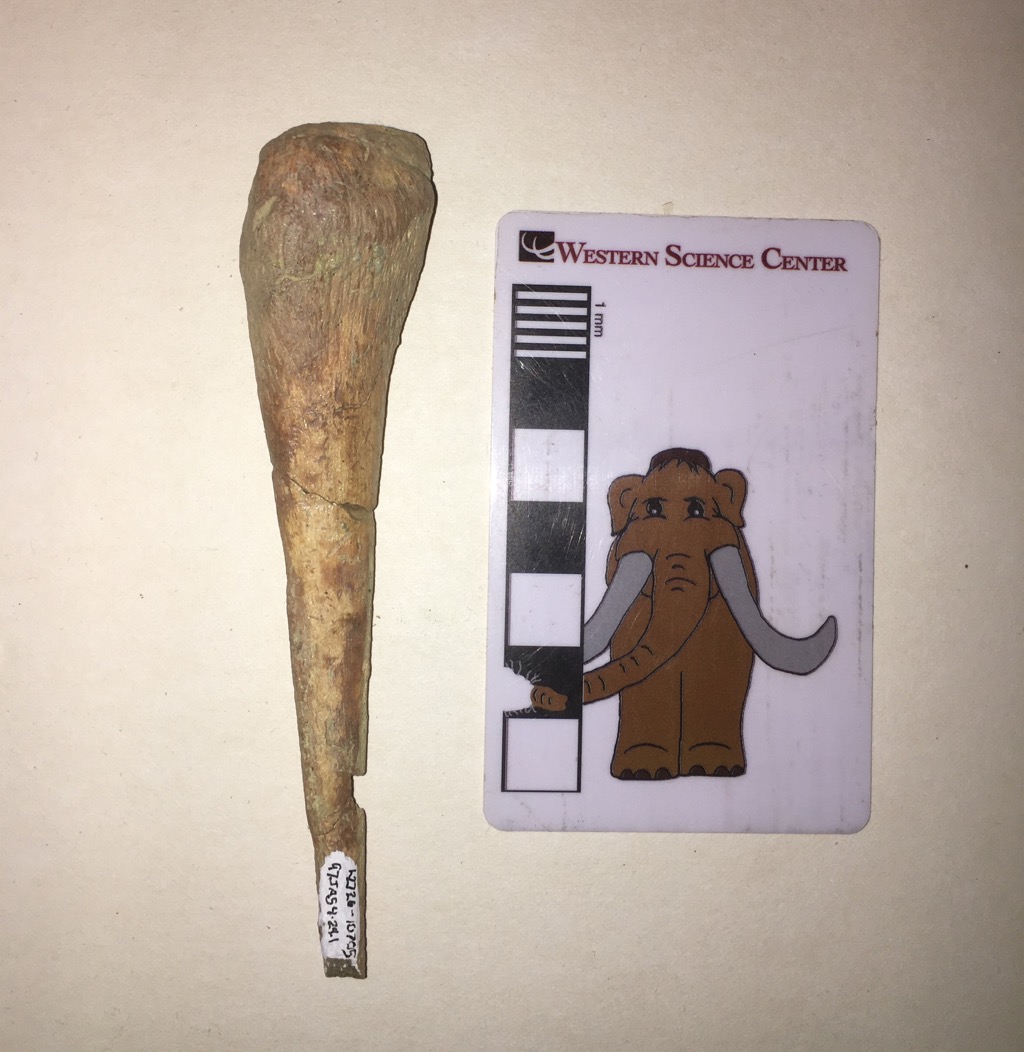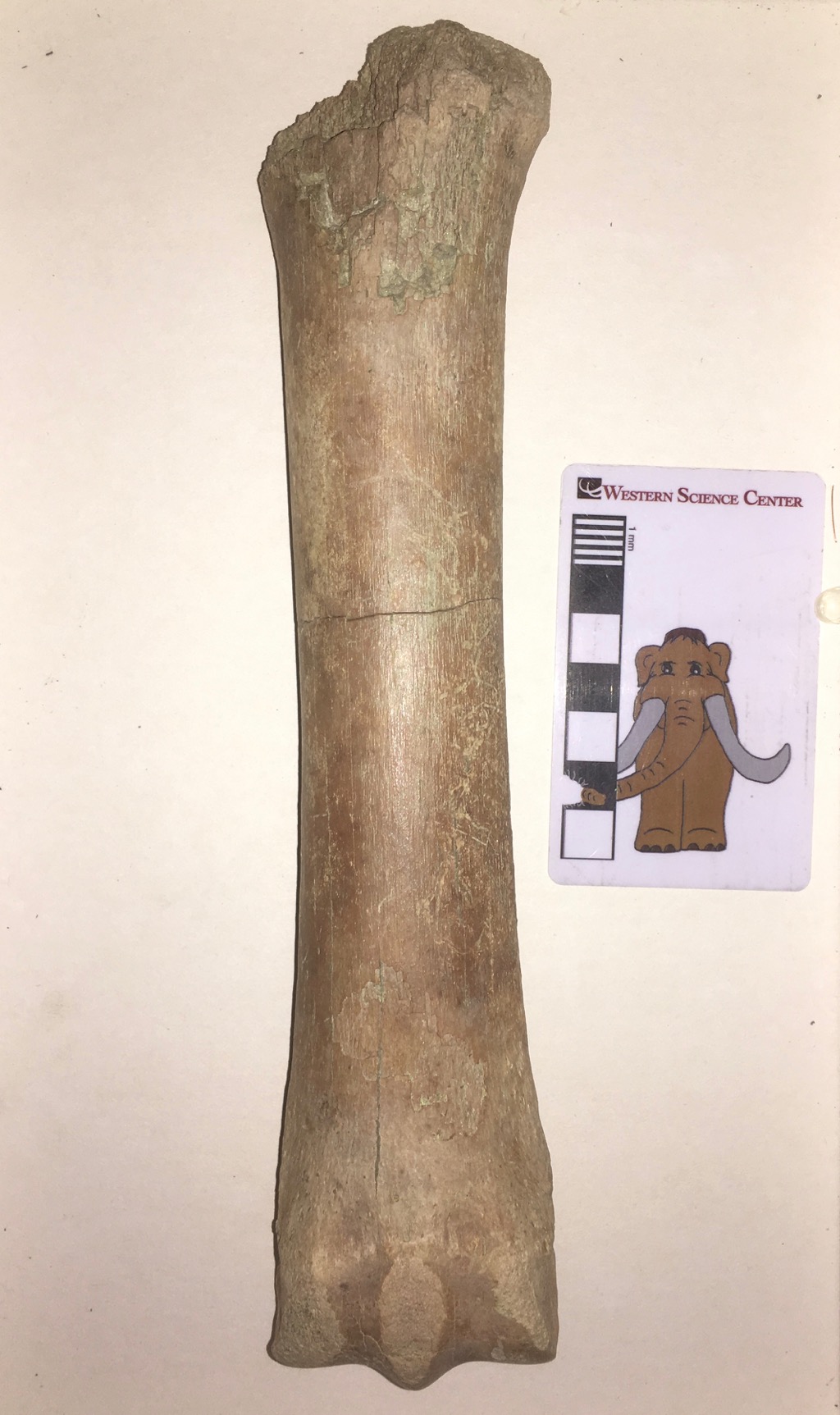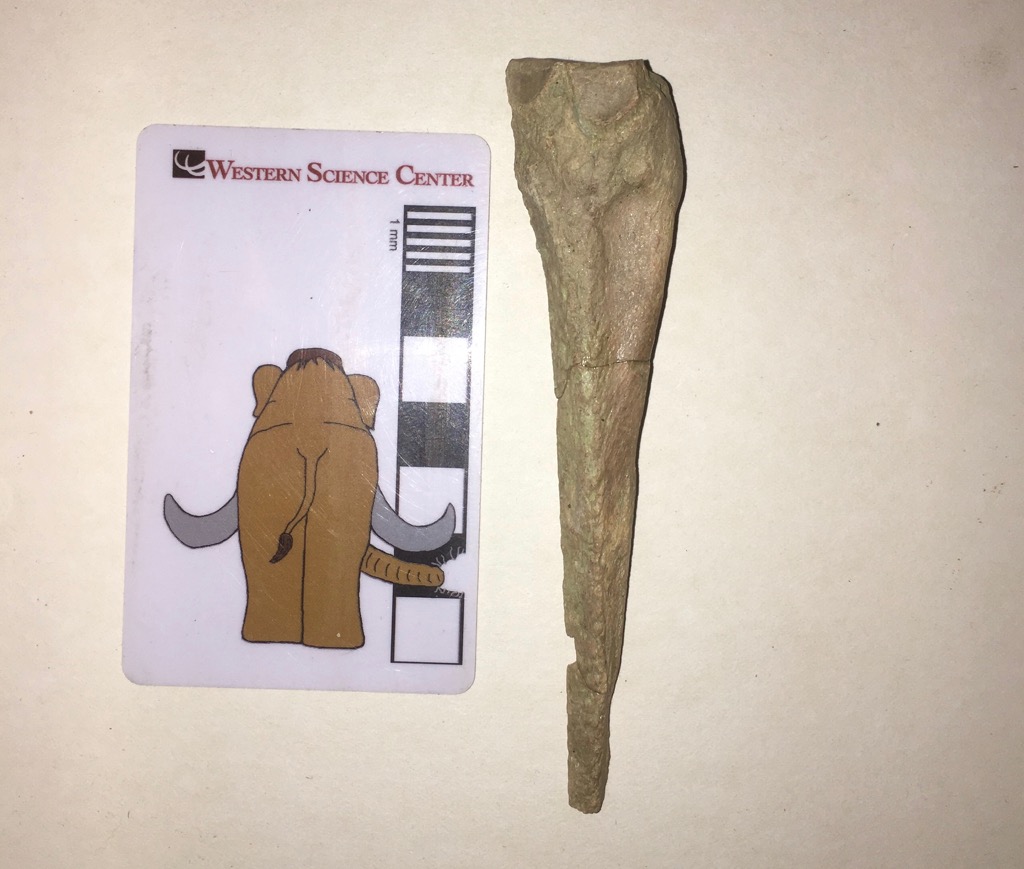 One of the joys of paleontology is that every fossil has a story. Through our understanding of anatomy, geology, ecology, and a host of other field, we can often reveal part of that story, and even a relatively small, nondescript fossil takes on a larger meaning.The small, pointed bone shown above is the right fourth metacarpal from a horse (Equus). The metacarpals are the bones that make up the hand or forefoot. At the proximal end they articulate with the wrist bones (the carpals) and often with the adjacent metacarpals. At the distal end they normally articulate with the first finger bones (the phalanges). In humans, the fourth metacarpal articulates with the ring finger. Our fingers (or digits) are numbered from 1 to 5, with the thumb being Digit I and the pinkie finger being Digit V; thus the ring finger is Digit IV. Toes are numbered the same way, with the big toe as Digit I.Horses famously only have a single hoof on each foot, corresponding to a single finger (on the front feet) or toe (on the back feet). The distal end of the bone shown above (at the bottom of the photo) clearly does not have any kind of articulation for the bones that make up the single finger on the horse's right foot. So what's going on?In horses, the hand bone that supports the animal's weight is the third metacarpal, not the fourth one. The right third metacarpal (probably from the same individual) is shown below:
One of the joys of paleontology is that every fossil has a story. Through our understanding of anatomy, geology, ecology, and a host of other field, we can often reveal part of that story, and even a relatively small, nondescript fossil takes on a larger meaning.The small, pointed bone shown above is the right fourth metacarpal from a horse (Equus). The metacarpals are the bones that make up the hand or forefoot. At the proximal end they articulate with the wrist bones (the carpals) and often with the adjacent metacarpals. At the distal end they normally articulate with the first finger bones (the phalanges). In humans, the fourth metacarpal articulates with the ring finger. Our fingers (or digits) are numbered from 1 to 5, with the thumb being Digit I and the pinkie finger being Digit V; thus the ring finger is Digit IV. Toes are numbered the same way, with the big toe as Digit I.Horses famously only have a single hoof on each foot, corresponding to a single finger (on the front feet) or toe (on the back feet). The distal end of the bone shown above (at the bottom of the photo) clearly does not have any kind of articulation for the bones that make up the single finger on the horse's right foot. So what's going on?In horses, the hand bone that supports the animal's weight is the third metacarpal, not the fourth one. The right third metacarpal (probably from the same individual) is shown below:  This massive bone is well-suited to holding up a horse's weight. So what about the fourth metacarpal? If it doesn't support a hoof, what does it do?As far as we can tell, pretty much nothing.The fourth metacarpal is a remnant of the horse's evolutionary history. While modern Equus is limited to a single hoof on each foot, supported by Digit III, horses' ancestors and extinct relatives had multiple hooves on each foot. The lateral toes were gradually lost, starting with Digits I and V, and later with Digits II and IV. The key here is gradually. Each digit eventually became small enough that it no longer functioned for walking; there would be a tiny hoof, but it didn't reach the ground. The hoof would eventually be lost, leaving only the metacarpal with no attached finger or toe. After even more time and generations, even the metacarpal is lost. But the whole process takes several million years.In the horse lineage, the first and fifth metacarpals were lost tens of millions of years ago. But the reduction of the second and fourth metacarpals has happened much more recently. Within the last 10 million years horse ancestors still had functional second and fourth toes, even if they were smaller than the central third toe. A few million years ago the second and fourth toes were finally lost altogether, leaving their corresponding metacarpals and metatarsals as the last remaining remnants of these digits. And that's where horses are today. The second and fourth metacarpals (and metatarsals) have lost their toes, and even the articulation to attach to the toes, and they're greatly reduced in size. At the proximal end they still articulate with the wrist bones and the third metacarpal (see the posterior view below). The presence of the fourth metacarpal is evolution caught in the act, a snapshot of a dynamic process that seems static because it happens so slowly. If horses survive a few million more years, the fourth metacarpal will probably be entirely lost, so that there is only a small slice of time (geologically speaking) when such a fossil could be preserved.
This massive bone is well-suited to holding up a horse's weight. So what about the fourth metacarpal? If it doesn't support a hoof, what does it do?As far as we can tell, pretty much nothing.The fourth metacarpal is a remnant of the horse's evolutionary history. While modern Equus is limited to a single hoof on each foot, supported by Digit III, horses' ancestors and extinct relatives had multiple hooves on each foot. The lateral toes were gradually lost, starting with Digits I and V, and later with Digits II and IV. The key here is gradually. Each digit eventually became small enough that it no longer functioned for walking; there would be a tiny hoof, but it didn't reach the ground. The hoof would eventually be lost, leaving only the metacarpal with no attached finger or toe. After even more time and generations, even the metacarpal is lost. But the whole process takes several million years.In the horse lineage, the first and fifth metacarpals were lost tens of millions of years ago. But the reduction of the second and fourth metacarpals has happened much more recently. Within the last 10 million years horse ancestors still had functional second and fourth toes, even if they were smaller than the central third toe. A few million years ago the second and fourth toes were finally lost altogether, leaving their corresponding metacarpals and metatarsals as the last remaining remnants of these digits. And that's where horses are today. The second and fourth metacarpals (and metatarsals) have lost their toes, and even the articulation to attach to the toes, and they're greatly reduced in size. At the proximal end they still articulate with the wrist bones and the third metacarpal (see the posterior view below). The presence of the fourth metacarpal is evolution caught in the act, a snapshot of a dynamic process that seems static because it happens so slowly. If horses survive a few million more years, the fourth metacarpal will probably be entirely lost, so that there is only a small slice of time (geologically speaking) when such a fossil could be preserved.
